

Scope statement. Scope statements may take many forms depending on the type of project being implemented and the nature of the organization.
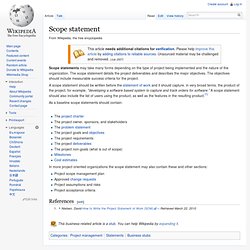
The scope statement details the project deliverables and describes the major objectives. The objectives should include measurable success criteria for the project. A scope statement should be written before the statement of work and it should capture, in very broad terms, the product of the project, for example, "developing a software based system to capture and track orders for software. " A scope statement should also include the list of users using the product, as well as the features in the resulting product.[1] Workforce productivity. Labour productivity US, Japan, Germany The OECD defines it as "the ratio of a volume measure of output to a volume measure of input".[1] Volume measures of output are normally gross domestic product (GDP) or gross value added (GVA), expressed at constant prices i.e. adjusted for inflation.

Scope (project management) In project management, the term scope has two distinct uses- Project Scope and Product Scope.
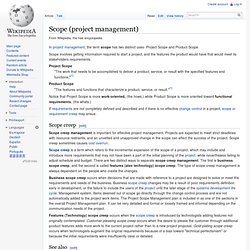
Scope involves getting information required to start a project, and the features the product would have that would meet its stakeholders requirements. Project Scope "The work that needs to be accomplished to deliver a product, service, or result with the specified features and functions. Constraint. A constraint is something that plays the part of a physical, social or financial restriction.

It is a derived form of the intransitive verb form constrained. Constraint may refer to: Theory of Constraints, in business managementLoading gauge or structure gauge (constraints in engineering)A constraint on constrained writing, in literature For example, Oulipian constraints In mathematics[edit] In computing[edit] In linguistics[edit] Optimality Theory, a constraint-based theory which is primarily influential in phonology. Productivity. Increasing national productivity can raise living standards because more real income improves people's ability to purchase goods and services, enjoy leisure, improve housing and education and contribute to social and environmental programs.
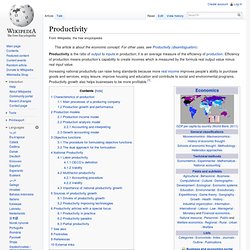
Productivity growth also helps businesses to be more profitable.[1] Characteristics of production[edit] Economic well-being is created in a production process, meaning all economic activities that aim directly or indirectly to satisfy human needs. Project management triangle. The Project Management Triangle The Project Management Triangle (called also Triple Constraint or the Iron Triangle) is a model of the constraints of project management. It is a graphic aid where the three attributes show on the corners of the triangle to show opposition. The Project Life Cycle. PM. The objective of project management is to produce a complete project which complies with the client's objectives.
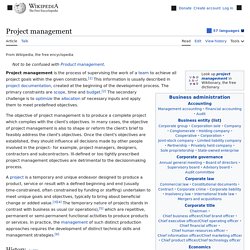
In many cases the objective of project management is also to shape or reform the client's brief to feasibly address the client's objectives. Once the client's objectives are clearly established they should influence all decisions made by other people involved in the project – for example project managers, designers, contractors and sub-contractors.
Ill-defined or too tightly prescribed project management objectives are detrimental to decision making. History[edit] Henry Gantt (1861–1919), the father of planning and control techniques PERT and CPM are very similar in their approach but still present some differences. What Makes Big Data Projects Succeed - Tom Davenport. By Tom Davenport | 12:00 PM March 26, 2014 In conversations with executives, many of the same misconceptions about big data projects — and what makes them successful — keep coming up.

To help clear the air and foster a better understanding of what makes big data initiatives succeed, here are some of the key things I’ve learned from companies that are realizing substantial business value with their big data initiatives. Technology: The most popular misconception many organizations have is that big data projects are all about technologies that are specific to big data—Hadoop, Python, Pig, Hive, etc. It is certainly true that those tools are important and useful to big data projects. But unless your company is a start-up, you probably have some legacy technologies and skills that can come in handy as well.
People: Just as you can hold onto some of your legacy technologies, you also don’t need to bring in entirely new people. International Journal of Project Management. Stakeholder Management. Scope Management. Stop Your Project Delivering Late and Over Budget The scope is the most important element to understand about any project.
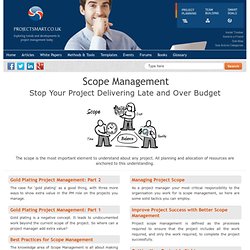
All planning and allocation of resources are anchored to this understanding. Home - Independent Project Analysis, Inc. Manegement Tools.
7 Essential Project Planning Documents. Solid project planning is a prerequisite for project success. Poor planning, meanwhile, can lead to missed deadlines, budget overruns, poor quality deliverables, frustrated project teams and even project failure. Objetives SMART. IPMA. APM Body of Knowledge 5th edition. Mundopm.com. SGP - Sou Gerente de Projetos - Podcast - Informações sobre ... PMI Fortaleza, Ceará Chapter. : : PMI-RIO : : PROJECT MANAGEMENT. Risk. Making project management indispensable for business results. © Using Expert Stakeholders Wisely. One group of stakeholders whose input is critical to most projects are experts -- subject matter experts, risk experts, quality experts.

PMI no Brasil - a Maior Associação Mundial para Profissionais de Gerenciamento de Projetos. 20+ Tools to Create Your Own Infographics. A picture is worth a thousand words – based on this, infographics would carry hundreds of thousands of words, yet if you let a reader choose between a full-length 1000-word article and an infographic that needs a few scroll-downs, they’d probably prefer absorbing information straight from the infographic.
What’s not to like? Colored charts and illustrations deliver connections better than tables and figures and as users spend time looking back and forth the full infographic, they stay on the site longer. Plus, readers who like what they see are more likely to share visual guides more than articles. While not everyone can make infographics from scratch, there are tools available on the Web that will help you create your very own infographics.
In this article, we’re listing more than 20 such options to help you get your messages across to your readers, visually. Read Also: The Infographic Revolution: Where Do We Go From Here? What About Me? “What About Me?” Vizualize.me Piktochart easel.ly. Online Tools.